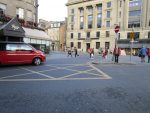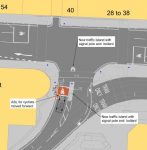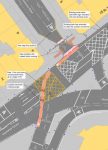Introduction
Living Streets Edinburgh Group (LSEG) is the local voluntary arm of the national charity, Living Streets, which campaigns for better conditions for ‘everyday walking’. In LSEG our key aim is to promote walking as a safe, enjoyable and easy way of getting around the city.
The main general point that we would want to make in relation to this consultation is that, while we understand the urgent need to review the tram routes in the light of the legitimate concerns for the safety of cyclists, the main victims of road vehicle collisions are pedestrians. Their needs should be at the forefront of thinking on improvements to the tram route, bearing in mind also that 99% of tram users access the tram on foot (or wheelchair). The motion to Council by Cllr Macinnes in June explicitly aimed to enhance pedestrian and cyclist safety and convenience (our emphasis); this initiative should therefore be named as ‘Tram Route Pedestrian and Cycle Safety Consultation’.
However there is little in this proposal to address the specific needs of pedestrians and we want to see much more vigorous action to address a number of long-standing problems which pedestrians face on the tram route in the city centre. In particular, we have frequently drawn attention to the unacceptably long wait times that people walking along Princes Street face when trying to cross adjoining streets such as Frederick Street, Hanover Street and South St David Street. We strongly recommend that the pedestrian phases are reviewed at all signalled junctions along Princes Street (and indeed along the entire route, for example at Haymarket). The aim would be to reduce the wait times for pedestrians to cross and if necessary increase ‘green man’ times and the frequency of crossing opportunities. Making these improvements will in turn increase pedestrian safety, as it will reduce the incidence of ‘red man’ crossing, which is encouraged by the unacceptably long times that people have to wait for the pedestrian phase.
 In addition, we believe that this is the right opportunity to install the ‘missing pedestrian crossing’ at Ryans Bar, which was approved by Transport and Environment Committee in August 2014 as part of the ‘post tram city centre review’. This is an important gap in pedestrian provision in the city centre; again this junction was explicitly referred to in Cllr Macinnes’ motion. This review should also consider other potential gaps in pedestrian networks where crossings are needed. One example would be another pedestrian crossing of Princes Street, to the west of South Charlotte Street and there are likely to be a number of others.
In addition, we believe that this is the right opportunity to install the ‘missing pedestrian crossing’ at Ryans Bar, which was approved by Transport and Environment Committee in August 2014 as part of the ‘post tram city centre review’. This is an important gap in pedestrian provision in the city centre; again this junction was explicitly referred to in Cllr Macinnes’ motion. This review should also consider other potential gaps in pedestrian networks where crossings are needed. One example would be another pedestrian crossing of Princes Street, to the west of South Charlotte Street and there are likely to be a number of others.
Finally, the city centre retains a considerable number of temporary features, many of which are trip hazards, such as rubber kerbs, patching of paving and other remnants of the tram construction which have not yet been properly remedied. Permanent reinstatement works are overdue. We can supply more detail on specific locations and issues.
Location-specific observations (west to east)
We make the following observations on some specific locations mentioned in the proposal which will affect people walking.
Haymarket Yards:
 We are happy with the design proposals for this location, which offer enhanced pedestrian crossing facilities. The main problem for pedestrians crossing Haymarket Yards however is the inordinately long wait that people walking often have to wait to cross this junction which has relatively little traffic. We would like to see signal timings altered in favour of people walking.
We are happy with the design proposals for this location, which offer enhanced pedestrian crossing facilities. The main problem for pedestrians crossing Haymarket Yards however is the inordinately long wait that people walking often have to wait to cross this junction which has relatively little traffic. We would like to see signal timings altered in favour of people walking.
Haymarket:
 North of Ryries/Starbucks is a severe pinch point for pedestrians, especially problematic when many passengers disembark from busy trains at Haymarket Station. There is also a step parallel to the kerb, separating the pavement from the carriageway here which is an unpleasant trip hazard. There appear to be no plans to improve this space for the thousands of pedestrians who use it and we would ask that improvements for walking here are introduced.
North of Ryries/Starbucks is a severe pinch point for pedestrians, especially problematic when many passengers disembark from busy trains at Haymarket Station. There is also a step parallel to the kerb, separating the pavement from the carriageway here which is an unpleasant trip hazard. There appear to be no plans to improve this space for the thousands of pedestrians who use it and we would ask that improvements for walking here are introduced.
Grosvenor Street:
 We welcome the narrowing of Grosvenor Street, which will make it easier for people walking to cross. We note that, to the immediate east of Grosvenor Street, the northern pavement of West Maitland Street is to be reduced from 4.9 to 3.8 metres. We would prefer not to see this, although, taken together with the improvements to crossing Grosvenor Street, we are minded to compromise on this as a net improvement for walking. However, this is dependent on the pavement being kept clear of clutter such as bins, poles, A-boards etc. We are therefore concerned at the note that “Existing cycle racks and traffic sign relocated to new footway area”. We seek assurances that if the pavement is narrowed, new obstructions are not placed on it: this would be entirely unacceptable.
We welcome the narrowing of Grosvenor Street, which will make it easier for people walking to cross. We note that, to the immediate east of Grosvenor Street, the northern pavement of West Maitland Street is to be reduced from 4.9 to 3.8 metres. We would prefer not to see this, although, taken together with the improvements to crossing Grosvenor Street, we are minded to compromise on this as a net improvement for walking. However, this is dependent on the pavement being kept clear of clutter such as bins, poles, A-boards etc. We are therefore concerned at the note that “Existing cycle racks and traffic sign relocated to new footway area”. We seek assurances that if the pavement is narrowed, new obstructions are not placed on it: this would be entirely unacceptable.
Princes Street at South St Andrew Street:
 We note that it is proposed to reduce the width of the pavement significantly – from 11.14 metres to 8.4 metres at the widest point and from 7.55 metres to 6.42 metres adjacent to the corner. While we understand the need to introduce an acceptable geometry for the cycle route crossing the tram tracks at this location, we oppose this potential loss of pedestrian space on Edinburgh’s principal pedestrian street which is used by over a million people every week (bit.ly/2qfA8Dp). The reduction of the space available to people on foot here would increase the risk of pedestrians spilling into the carriageway/tram tracks. A shared walking/cycling space or a cycle bypass bisecting the pavement would also be totally unacceptable and we call for a fresh approach to improving cycling safety – which does not compromise pedestrian safety or convenience – at this key location.
We note that it is proposed to reduce the width of the pavement significantly – from 11.14 metres to 8.4 metres at the widest point and from 7.55 metres to 6.42 metres adjacent to the corner. While we understand the need to introduce an acceptable geometry for the cycle route crossing the tram tracks at this location, we oppose this potential loss of pedestrian space on Edinburgh’s principal pedestrian street which is used by over a million people every week (bit.ly/2qfA8Dp). The reduction of the space available to people on foot here would increase the risk of pedestrians spilling into the carriageway/tram tracks. A shared walking/cycling space or a cycle bypass bisecting the pavement would also be totally unacceptable and we call for a fresh approach to improving cycling safety – which does not compromise pedestrian safety or convenience – at this key location.
David Hunter
for Living Streets Edinburgh Group